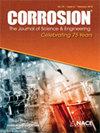Pre-treatment of Carbon Steel with Hybrid Film Modified with Different Natural Inhibitors (Garlic and Cocoa)
IF 1.3
4区 材料科学
Q4 MATERIALS SCIENCE, MULTIDISCIPLINARY
引用次数: 0
Abstract
One way to protect carbon steel from corrosion is through pre-treatment and corrosion inhibitors, such as the use of silane layers that can protect against corrosion. In this study, the corrosion resistance of the TEOS/GPTMS (Tetraethyl orthosilicate / 3-Glycidoxypropyltrimethoxysilane) hybrid film modified with garlic peel powder or cocoa shell powder on carbon steel was evaluated. By electrochemical impedance spectroscopy (EIS) it was observed that the incorporation of inhibitors promoted higher values of impedance modulus compared to the bare metal substrate or in absence of inhibitor, and the concentration of 1.77 g L−1 provided the best performance for both natural inhibitors. The Fourier transform infrared spectroscopy (FTIR) showed that the addition of inhibitors to the hybrid film promoted a better hydrolysis in the formation of the films. By the Scanning Electron Microscopy and Energy Dispersive Spectroscopy (SEM/EDS) it was noted that there was the formation of the hybrid film on the metal surface, and the insertion of the inhibitor to the silane film enabled the formation of grains that precipitate from the deposition of the inhibitor on the substrate surface. The Scanning Vibrating Electrode Technique (SVET) shows that the inhibitors improved corrosion resistance of the hybrid film, corroborating with the EIS analysis. The contact angle shows that the presence of the inhibitor in the silane film makes it less hydrophilic. The roughness profile shows that the hybrid film with cocoa has the highest roughness represented by a higher average value of Average Roughness (Rz).用不同天然抑制剂(大蒜和可可)改性的混合膜预处理碳钢
保护碳钢免受腐蚀的方法之一是通过预处理和腐蚀抑制剂,例如使用硅烷层来防止腐蚀。本研究评估了用大蒜皮粉或可可壳粉修饰的 TEOS/GPTMS(正硅酸四乙酯/3-缩水甘油氧丙基三甲氧基硅烷)混合膜在碳钢上的耐腐蚀性。通过电化学阻抗光谱(EIS)观察到,与裸金属基底或没有抑制剂的情况相比,抑制剂的加入会使阻抗模量值升高,而 1.77 g L-1 的浓度为两种天然抑制剂提供了最佳性能。傅立叶变换红外光谱(FTIR)显示,在混合薄膜中添加抑制剂能更好地促进薄膜的水解。扫描电子显微镜和能量色散光谱仪(SEM/EDS)显示,金属表面形成了混合膜,在硅烷膜中加入抑制剂后,抑制剂在基底表面沉积形成了晶粒。扫描振动电极技术(SVET)表明,抑制剂提高了混合薄膜的耐腐蚀性,这与 EIS 分析结果相吻合。接触角显示,硅烷薄膜中抑制剂的存在使其亲水性降低。粗糙度曲线显示,含有可可的混合薄膜的粗糙度最高,平均粗糙度 (Rz) 的平均值较高。
本文章由计算机程序翻译,如有差异,请以英文原文为准。
求助全文
约1分钟内获得全文
求助全文
来源期刊

Corrosion
MATERIALS SCIENCE, MULTIDISCIPLINARY-METALLURGY & METALLURGICAL ENGINEERING
CiteScore
2.80
自引率
12.50%
发文量
97
审稿时长
3 months
期刊介绍:
CORROSION is the premier research journal featuring peer-reviewed technical articles from the world’s top researchers and provides a permanent record of progress in the science and technology of corrosion prevention and control. The scope of the journal includes the latest developments in areas of corrosion metallurgy, mechanisms, predictors, cracking (sulfide stress, stress corrosion, hydrogen-induced), passivation, and CO2 corrosion.
70+ years and over 7,100 peer-reviewed articles with advances in corrosion science and engineering have been published in CORROSION. The journal publishes seven article types – original articles, invited critical reviews, technical notes, corrosion communications fast-tracked for rapid publication, special research topic issues, research letters of yearly annual conference student poster sessions, and scientific investigations of field corrosion processes. CORROSION, the Journal of Science and Engineering, serves as an important communication platform for academics, researchers, technical libraries, and universities.
Articles considered for CORROSION should have significant permanent value and should accomplish at least one of the following objectives:
• Contribute awareness of corrosion phenomena,
• Advance understanding of fundamental process, and/or
• Further the knowledge of techniques and practices used to reduce corrosion.
 求助内容:
求助内容: 应助结果提醒方式:
应助结果提醒方式:


